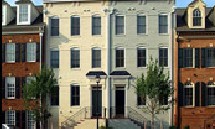| publicly-owned land: overview » introduction » identify opportunities |
| Click on the links below to learn more about identifying suitable publicly-owned parcels: | |
 Photo courtesy of ULI Development Case Studies | Work across agencies to identify suitable publicly-owned land for conversion to affordable housing. Think creatively about the opportunities on publicly-owned land. For example, actively-used public sites can be transformed into mixed-use properties that include affordable housing. |
| You are currently reading: Identify opportunities on publicly-owned land across all agencies Numerous government departments and agencies, with and without housing-related missions, hold surplus or underutilized property which could be suitable for the development of affordable homes. An interagency task force can ensure that the inventory of potential parcels is as comprehensive as possible. Other pages in this section:  Prioritize the use of suitable publicly-owned land for affordable homes Prioritize the use of suitable publicly-owned land for affordable homesThrough legal mechanisms such as ordinances and codes, governments can authorize the use of underutilized or surplus public land for affordable homes whenever feasible. Ordinances and codes can also clarify procedures for marketing available parcels and ensuring that affordable housing goals are met.  Reduce barriers to the disposition of publicly-owned land for affordable homes Reduce barriers to the disposition of publicly-owned land for affordable homesStandard disposition procedures may hinder the transfer of publicly-owned property for affordable homes. Special transfer procedures, including expedited timelines and the authorization of below-market sales can facilitate the use of publicly-owned land for affordable homes Click here to view other resources on the use of publicly-owned land. |
| Interagency coordination through a task force or other process can uncover underutilized or surplus land that housing agencies would have been unlikely to find on their own. Communities may want to maintain this information in a unified and regularly updated list of underutilized and surplus land, either for internal use or as a resource available to developers and other interested members of the public. In addition, participation on a task force may help agencies without a housing focus to understand the strong need for additional affordable homes in the area and the public purpose that is served by using publicly-owned land to increase the supply of affordable homes. For example, as part of New York City's New Housing Marketplace plan to create or preserve 165,000 units of affordable housing in ten years, the city's Department of Housing Preservation and Development has worked with other city departments to acquire underutilized and surplus sites for affordable housing development. These sites include a historic public school in East Harlem and other Department of Education properties, underutilized parking lots owned by the Department of Transportation, a former hospital on Staten Island, and surplus land at a Brooklyn psychiatric hospital. Click here to read about New York City's New Housing Marketplace plan. | Solutions in Action |
| The Office of Real Estate Management in the Massachusetts Division of Capital Assets Management (DCAM) maintains an inventory of all state-owned real property, including property identified as surplus, in the MAssets (Massachusetts Assets) database. Users of the database, or the PDF report created from it, can find out which properties have been declared surplus and a variety of details about each property such as the location, responsible agency, acreage, and the square-footage of any structures on the land. Click here to leave this site and read more about MAssets. |
| Solutions in Action |
| Due to the limited availability of land in New York City for housing development, the city has decided to think creatively about developing affordable housing on underutilized publicly-owned sites. For example, a Department of Transportation parking lot in the Williamsburg section of Brooklyn will be converted to a covered parking lot in a building that also includes housing. As part of its New Housing Marketplace plan, the city plans to actively consider the potential of all underutilized publicly-owned sites, such as low-rise structures in areas that permit mid-rise or high-rise buildings, to determine the feasibility of incorporating affordable homes on the premises. |
| Solutions in Action |
| Georgia's Department of Community Affairs assists communities in assembling financing for the adaptive reuse of buildings that have become obsolete but have a sentimental and historic value to the community. Converting public buildings into affordable housing has happened frequently in the state -- often using former schools that community members will not allow to be demolished. In the City of Rossville, the adaptive reuse of South Rossville Elementary School created 60 one- and two-bedroom apartments affordable to low- to moderate-income senior citizens. The development, South Rossville Senior Village, is home to many senior citizens who once attended or taught at the school and includes a community room and other recreational amenities. In Atlanta, the Crogman School building, where the Rev. Martin Luther King, Jr.'s mother once taught, was saved from demolition and converted into a 105-unit affordable housing complex. In both of these cases, homes were created in the original school building and in one or more new buildings on the site. |